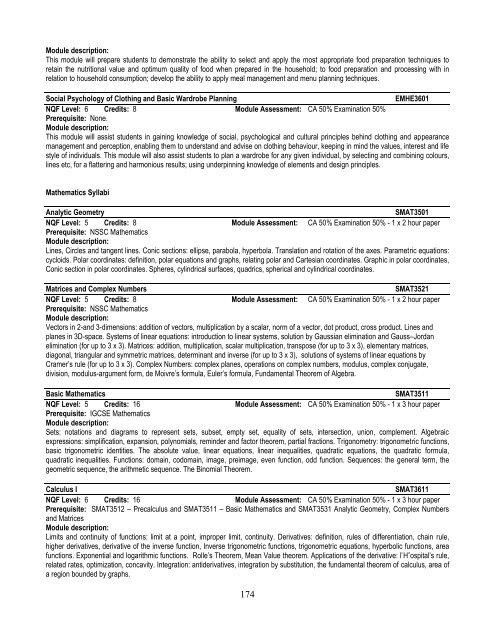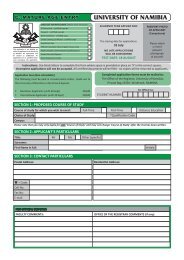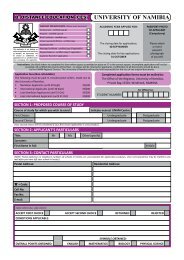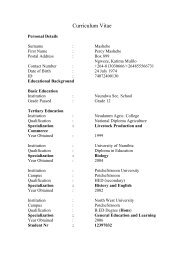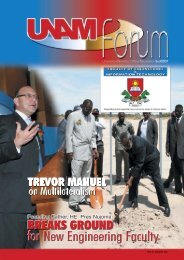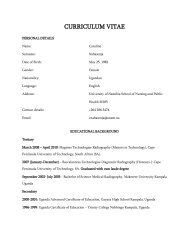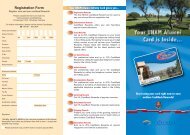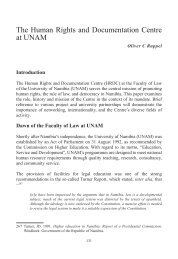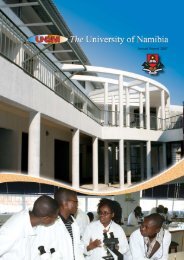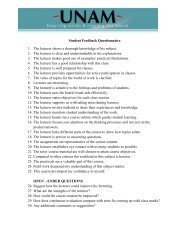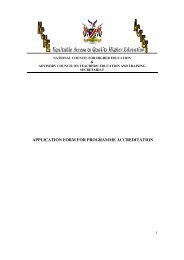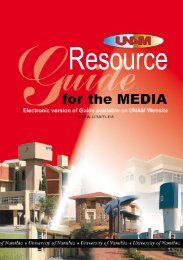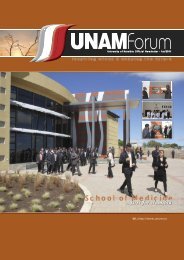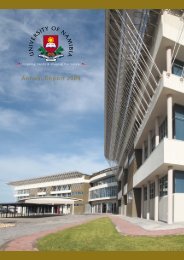UNIVERSITY OF NAMIBIA CENTRE FOR EXTERNAL STUDIES ...
UNIVERSITY OF NAMIBIA CENTRE FOR EXTERNAL STUDIES ...
UNIVERSITY OF NAMIBIA CENTRE FOR EXTERNAL STUDIES ...
You also want an ePaper? Increase the reach of your titles
YUMPU automatically turns print PDFs into web optimized ePapers that Google loves.
Module description:This module will prepare students to demonstrate the ability to select and apply the most appropriate food preparation techniques toretain the nutritional value and optimum quality of food when prepared in the household; to food preparation and processing with inrelation to household consumption; develop the ability to apply meal management and menu planning techniques.Social Psychology of Clothing and Basic Wardrobe PlanningEMHE3601NQF Level: 6 Credits: 8 Module Assessment: CA 50% Examination 50%Prerequisite: None.Module description:This module will assist students in gaining knowledge of social, psychological and cultural principles behind clothing and appearancemanagement and perception, enabling them to understand and advise on clothing behaviour, keeping in mind the values, interest and lifestyle of individuals. This module will also assist students to plan a wardrobe for any given individual, by selecting and combining colours,lines etc, for a flattering and harmonious results; using underpinning knowledge of elements and design principles.Mathematics SyllabiAnalytic GeometrySMAT3501NQF Level: 5 Credits: 8 Module Assessment: CA 50% Examination 50% - 1 x 2 hour paperPrerequisite: NSSC MathematicsModule description:Lines, Circles and tangent lines. Conic sections: ellipse, parabola, hyperbola. Translation and rotation of the axes. Parametric equations:cycloids. Polar coordinates: definition, polar equations and graphs, relating polar and Cartesian coordinates. Graphic in polar coordinates,Conic section in polar coordinates. Spheres, cylindrical surfaces, quadrics, spherical and cylindrical coordinates.Matrices and Complex NumbersSMAT3521NQF Level: 5 Credits: 8 Module Assessment: CA 50% Examination 50% - 1 x 2 hour paperPrerequisite: NSSC MathematicsModule description:Vectors in 2-and 3-dimensions: addition of vectors, multiplication by a scalar, norm of a vector, dot product, cross product. Lines andplanes in 3D-space. Systems of linear equations: introduction to linear systems, solution by Gaussian elimination and Gauss–Jordanelimination (for up to 3 x 3). Matrices: addition, multiplication, scalar multiplication, transpose (for up to 3 x 3), elementary matrices,diagonal, triangular and symmetric matrices, determinant and inverse (for up to 3 x 3), solutions of systems of linear equations byCramer’s rule (for up to 3 x 3). Complex Numbers: complex planes, operations on complex numbers, modulus, complex conjugate,division, modulus-argument form, de Moivre’s formula, Euler’s formula, Fundamental Theorem of Algebra.Basic MathematicsSMAT3511NQF Level: 5 Credits: 16 Module Assessment: CA 50% Examination 50% - 1 x 3 hour paperPrerequisite: IGCSE MathematicsModule description:Sets: notations and diagrams to represent sets, subset, empty set, equality of sets, intersection, union, complement. Algebraicexpressions: simplification, expansion, polynomials, reminder and factor theorem, partial fractions. Trigonometry: trigonometric functions,basic trigonometric identities. The absolute value, linear equations, linear inequalities, quadratic equations, the quadratic formula,quadratic inequalities. Functions: domain, codomain, image, preimage, even function, odd function. Sequences: the general term, thegeometric sequence, the arithmetic sequence. The Binomial Theorem.Calculus ISMAT3611NQF Level: 6 Credits: 16 Module Assessment: CA 50% Examination 50% - 1 x 3 hour paperPrerequisite: SMAT3512 – Precalculus and SMAT3511 – Basic Mathematics and SMAT3531 Analytic Geometry, Complex Numbersand MatricesModule description:Limits and continuity of functions: limit at a point, improper limit, continuity. Derivatives: definition, rules of differentiation, chain rule,higher derivatives, derivative of the inverse function, Inverse trigonometric functions, trigonometric equations, hyperbolic functions, areafunctions. Exponential and logarithmic functions. Rolle’s Theorem, Mean Value theorem. Applications of the derivative: l’Hˆospital’s rule,related rates, optimization, concavity. Integration: antiderivatives, integration by substitution, the fundamental theorem of calculus, area ofa region bounded by graphs.174


